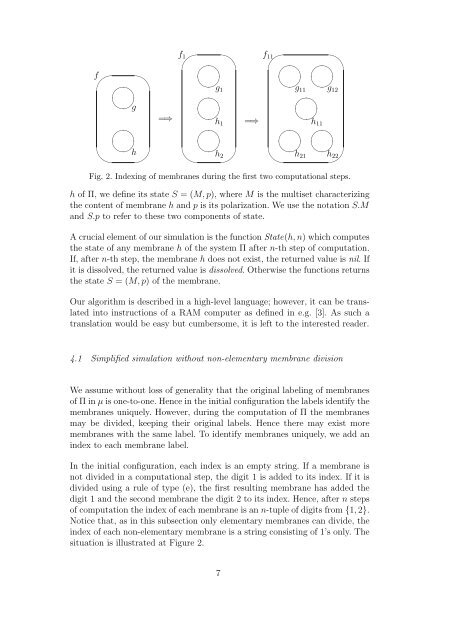P Systems with Active Membranes Characterize PSPACE
P Systems with Active Membranes Characterize PSPACE
P Systems with Active Membranes Characterize PSPACE
You also want an ePaper? Increase the reach of your titles
YUMPU automatically turns print PDFs into web optimized ePapers that Google loves.
f✬1✩f 11✬✩✛✘✛✘✛✘f✬✩✛✘✚g ✙✚✙✚✙1g 11 g 12✛✘✛✘✚g✙=⇒ ✚✙✚✙h 1 =⇒h 11✛✘✛✘✛✘✛✘✚h✙✚✙✚✙✚✙h 2 h 21 h 22✫ ✪ ✫ ✪ ✫✪Fig. 2. Indexing of membranes during the first two computational steps.h of Π, we define its state S = (M, p), where M is the multiset characterizingthe content of membrane h and p is its polarization. We use the notation S.Mand S.p to refer to these two components of state.A crucial element of our simulation is the function State(h, n) which computesthe state of any membrane h of the system Π after n-th step of computation.If, after n-th step, the membrane h does not exist, the returned value is nil. Ifit is dissolved, the returned value is dissolved. Otherwise the functions returnsthe state S = (M, p) of the membrane.Our algorithm is described in a high-level language; however, it can be translatedinto instructions of a RAM computer as defined in e.g. [3]. As such atranslation would be easy but cumbersome, it is left to the interested reader.4.1 Simplified simulation <strong>with</strong>out non-elementary membrane divisionWe assume <strong>with</strong>out loss of generality that the original labeling of membranesof Π in µ is one-to-one. Hence in the initial configuration the labels identify themembranes uniquely. However, during the computation of Π the membranesmay be divided, keeping their original labels. Hence there may exist moremembranes <strong>with</strong> the same label. To identify membranes uniquely, we add anindex to each membrane label.In the initial configuration, each index is an empty string. If a membrane isnot divided in a computational step, the digit 1 is added to its index. If it isdivided using a rule of type (e), the first resulting membrane has added thedigit 1 and the second membrane the digit 2 to its index. Hence, after n stepsof computation the index of each membrane is an n-tuple of digits from {1, 2}.Notice that, as in this subsection only elementary membranes can divide, theindex of each non-elementary membrane is a string consisting of 1’s only. Thesituation is illustrated at Figure 2.7
















